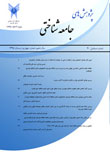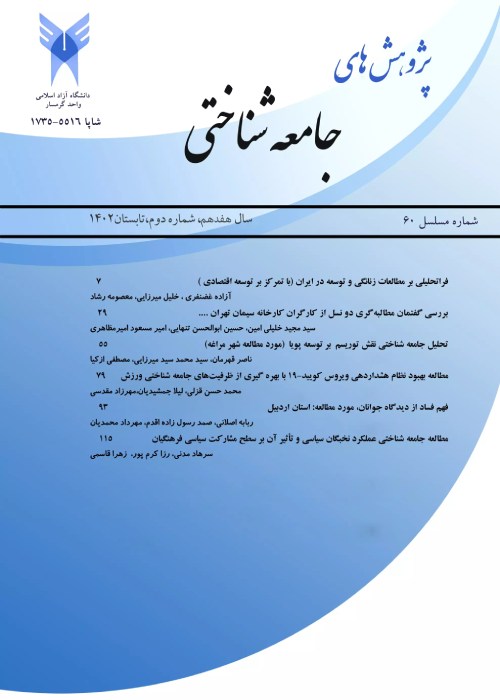فهرست مطالب

مجله پژوهش های جامعه شناختی
سال دهم شماره 3 (پیاپی 40، پاییز 1395)
- تاریخ انتشار: 1395/09/17
- تعداد عناوین: 9
-
صفحه 107
-
Page 7The purpose of this research is, comparing the relationship between power structure in family and mental health in two groups of female teachers. The research method is descriptive and of correlation type. The statistical population in this research includes all married female teachers in primary and secondary schools in Shiraz during 2008-2009. A sample of 160 married teachers of primary schools are selected by a multistage sampling and two questionnaires are distributed by chance among quadruple areas of Shiraz. In this research, 5 primary and secondary schools are selected by chance, 4 teachers were selected to do subsequent stages of research, and from each area in primary and secondary school. The data tools are two questionnaires which are: 1- Questionnaire of power structure in family.
2- Questionnaire of public health (GHQ-28).
Analyzing data is done in both level, descriptive statistics and inferential statistics. Finally we see that there is a meaning full relationship between power structure and mental health but there is no significant relationship between family relations and mental health. But among other variables only period length of marriage can predict mental health.Keywords: Power structure, mental health, family -
Page 21Nowadays, the tradition as one of the reasons in recognition of Islamic law has a value. Studying Imam Alis life show us that he only aimed to preserve the unity of Islam and the Muslims and in the caliphate issue, which was the first dispute arose among the Muslim Ummah, with patience and silence he did not allow these differences to undermine the unity of the Muslim Ummah. Since cohesion and social cohesion is one of the most important functions of the media in the present day, the national media as an arm of the Islamic government plays an important role in order to maintain unity and social order and the creation of beliefs, feelings and behaviors common among people of different ranks in Muslim community. Because in his perspective, cohesion and unity of the community members are the main factors that help ensure their success to the growing community. The method used in this study is descriptive, analytical, along with the historical method and follow this question that what are some ways for the national media to maintain unity and social cohesion according to tradition of Imam Ali (A.S.)?Keywords: Imam Ali's life, Nahj al-Balagha, media, method, social cohesion
-
Page 45Human phenomena are Significant and all works that are created by humans can carry meaning. These meanings are cultural constructs. Understanding of these meanings is the task of cultural sociology. The main goal of the cultural sociology is showing of aspects of the collective unconscious. This result is based on unconscious cultural structures that lead society to the ideas of the Enlightenment and however, the process of understanding may change, but the structure does not break apart because Society cannot survive without these structures. The main question in this paper is what is cultural meaning of technology from the perspective of cultural sociology? This study seeks to determine the cultural meaning of technology with knowledge and method of cultural sociology; also we try to mine symbols, codes and narratives about technology according to cultural sociologists. According to cultural sociologists, Considered in its social referenceits economic and scientific formstechnology is a thing that can be touched, observed, interacted with, and calculated in an objectively rational way. Analytically, however, technology is also part of the cultural order. It is a sign, both a signifier and a signified, in relation to which actors cannot entirely separate their subjective states of mind. Social scientists have not usually considered technology in this more subjective way. In- deed, they have not typically considered it as a cultural object at all. It has appeared as the material variable par excellence, not as a point of scarcity but as the most routine of the routine, not a sign but an antisign, the essence of a modernity that has undermined the very possibility for cultural understanding itself. Cultural sociologists try to study technology culturally.Keywords: Technology, Cultural Sociology, Technological revolution
-
Page 71The aim of this study was to evaluate the role of new social networks in the legal aspect of identity of young citizens. For this purpose, the legal aspect identity of the citizen that has several components contains the civil, political and cultural examined among users of these networks. In this study, survey method was used, so using the techniques of interviews and questionnaires were used to collect data, validity by Cronbach's alpha 912 /. Was estimated in the study sample consisted of 372 subjects stratified sampling among 16- to 18 -year-old city of Tabriz were selected. The new social network user youth less than 1 to more than 6 hours a day were using. Also, the identity of young citizens in the legal aspect was considered moderate, and between the use of social networking with civil and political components of the legal aspect identity of the citizen were correlation negative linear average, and between the use of social networking with the legal aspect of the cultural component identity of the citizen was observed a positive linear correlation. The types and use of social networks by users on the identity of the citizens of their rights have been effective. Users who were using more of the social network in the components of culture were more flexible and more open. But in front of the civil and political elements were critics & opposites.Keywords: aspect the civil identity of the citizen, the political dimension of citizenship identity, the cultural identity of the citizens, social networks new
-
Page 87The goal of conducting the research is the investigation into the impact of wrestling on the social correlation in Mazandaran province villages. the case studies of Babol and Jooybars villages. The present research has been accomplished by the survey method and documentary and library
methods also have been utilized as complementary ones in order to recognition of the existent position and achieving the social reality. The questionnaire has been used for data collection. 395 persons are the statistical society of the research whom have been selected out of the entire villages of Babol and Jooybar via the Cochrans sampling method. The statistical society includes 210 men and 185 women. The amount of assurance level has been considered 0.99 in the research. In other words the maximum level of error for testing the hypotheses is 0.01.
In
accordance with the findings of the research, the correlation coefficient between wrestling and social correlation is 0.806 which reveals a positive and meaningful relation between these two variables. Therefore it can be concluded that there is a strong relation between sports specially wrestling and social correlation in rural society. Considering the intensity of observed correlation, the individuals social correlation increases by augmentation in participation and attention to wrestling in area. Also according to respondents, there is a positive and meaningful relation between the impacts of wrestling and holding its competitions at the regional level in dimensions of tourist attraction, physical and spiritual health, increase in social participation, confidence, communication, and understanding.Keywords: Social Correlation, Participation, Confidence, Communications, Understanding, Loochoo Traditional Wrestling -
Page 107Changes in marriage patterns and methods of raising a family, following the transition from a traditional to a modern society, have led to alternations in goals, function, and necessity of raising a family. The present study was a comparative study examining single and married peoples attitudes toward marriage function. The method of this study was qualitative. The statistical population included all single and married men and women in Tehran. The sample contained 55 single men, 57 married men, 66 single women, and 60 married women whom were selected using convenience and purposive sampling methods. Statistical analysis, initially, were conducted through content analysis of subjects responses to an open question, what is the marriage function?, and after categorizing the responses by several psychologists, using nonparametric chi-square test, consistency of single and married peoples opinions was examined. The subjects responses to 6 components of physical, psychological, social, economic, religious and spiritual functions were categorized. Comparing single and married men and women groups demonstrated significant differences in these categories. Single and married peoples opinions on marriage physiological function were consistent. Regarding psychological, social, and economic functions, opinions were not consistent. Single people mentioned these categories more than married people and married people mentioned religious and spiritual categories more than single people. Consistency and inconsistency of single and married mens and womens opinions indicate some changes in peoples views on marriage function; however, people still consider some functions and benefits for marriage and have a tendency toward it.Keywords: marriage, family, content analysis, qualitative research
-
Page 127Social participation is one way of growth and development of human society in this era. The aim of this study is to evaluate the effect of happiness on social participation (formal and informal) among students. The theoretical framework is a composition of Halley's theory about the origin of social participation and community involvement joy of Durkheim. Methodology is survey and to collect data a questionnaire is distributed and the reliability of it is also assessed and Cronbach's alpha is used too. To determine the sample size, Cochrans formula is used. The statistical population consists of students of Islamic Azad University in Tabriz in 2015 and a sample of 323 people is selected by stratified sampling. T-test results show that the mean difference is not significant in terms of gender and social participation. The Pearson correlation coefficient shows that there is a relationship between social participation and a sense of joy (0.408).Keywords: Happiness, social participation, formal, informal social participation, students
-
Page 147In today's organizations, cultural intelligence and high emotional intelligence can have a significant role in improving the organization's position and strengthening job performance. The main objective of this study is to investigate the relationship between cultural intelligence and emotional intelligence on job performance in one of the government agencies. The research method is descriptive - survey and correlation. The statistical population includes all employees in a government agency based on the sample of 280 randomly selected by a sampling method. Cultural Intelligence Scale for measuring is done by Ang, et al. (2007) questionnaire and to measure emotional intelligence, Goleman's Emotional Intelligence Questionnaire (1998) and a questionnaire to measure job performance, Hrsy- Goldsmith questionnaire are used. Data analysis is executed by descriptive and inferential statistics (correlation coefficient and stepwise regression). The results show that between cultural intelligence and all dimensions - strategy, knowledge, motivation and behavior, there is a significant positive relationship with job performance. Results also show that the dimensions of emotional intelligence-selfawareness, self-regulation, self-motivation, empathy and social skills have a significant relationship with job performance. Finally, to test the theoretical model of major and minor, a structural equation modeling is used and the high fit indices show great support from foundations of speculative data.Keywords: Cultural intelligence, emotional intelligence, business performance, strategy, knowledge
-
Page 177Today, people in informal conversation, a lot of words and pronunciation are different from each other. However, differences in pronunciation speakers in a linguistic community, is a natural phenomenon in most world languages (such as English, Arabic, Chinese, etc.) can be seen. So that the difference in pronunciation of some words in Persian, or the evolution of pronunciation, natural and selfevident. But in recent years, several factors have caused the difference in pronunciation of Persian vocabulary is of particular importance, including: - cyberspace and social networks, the development of broadcasting and production. This paper aims to impact virtual network in different Persian pronunciation of some words has been done.Keywords: Social Networks, Pronunciation, Words of Persian language


